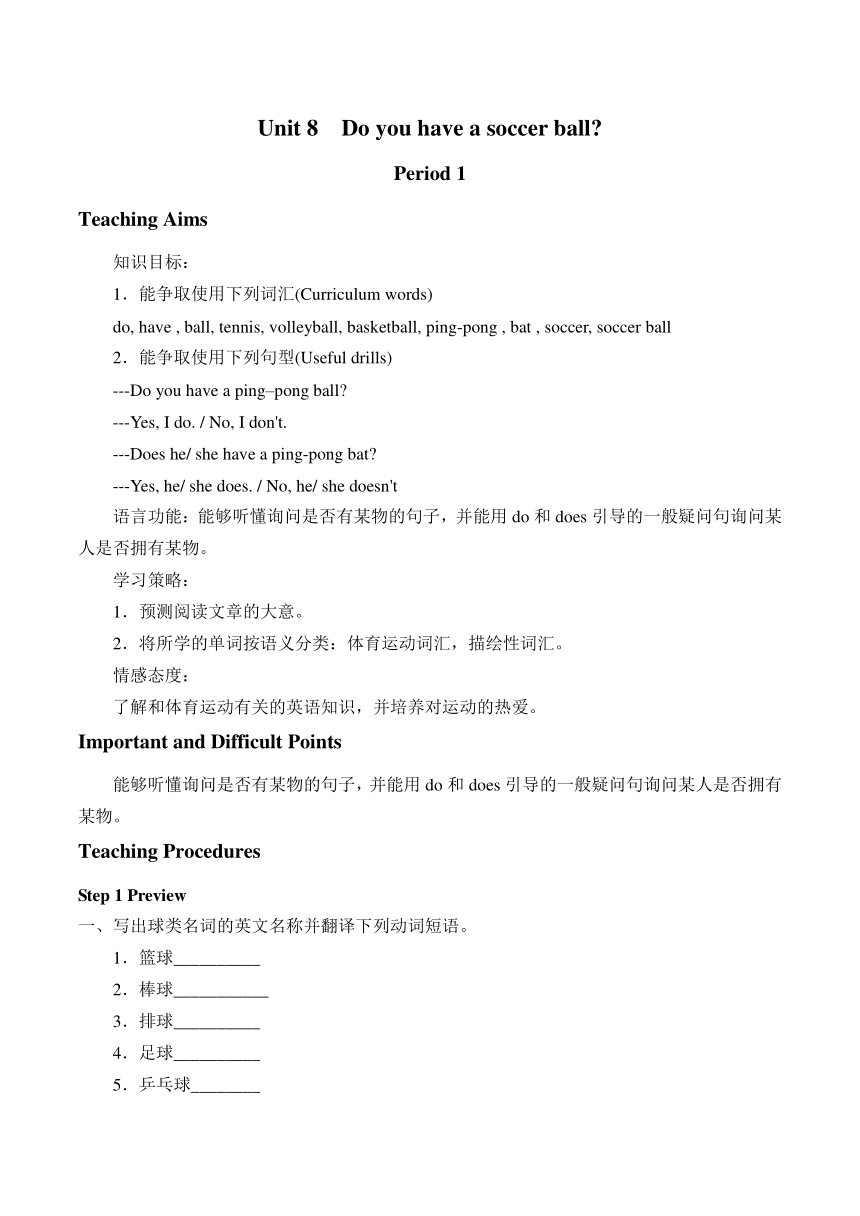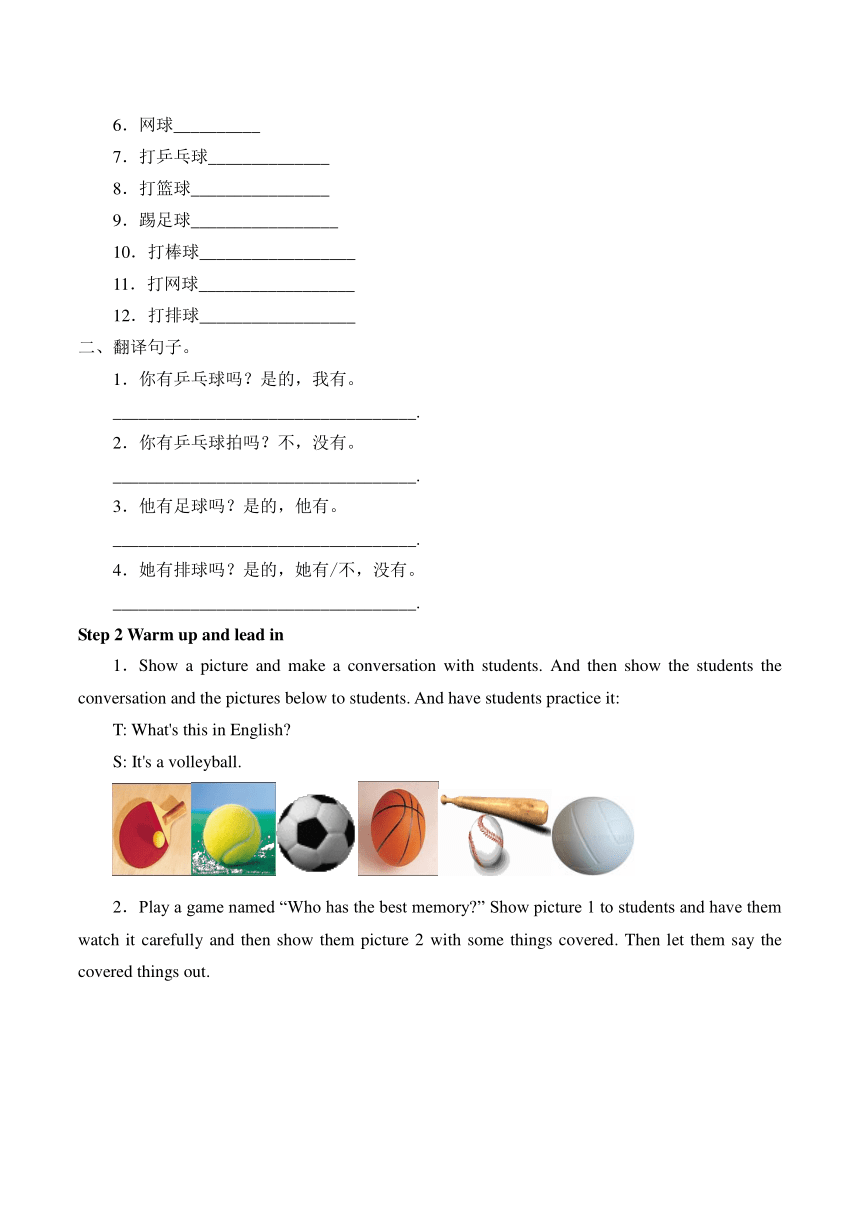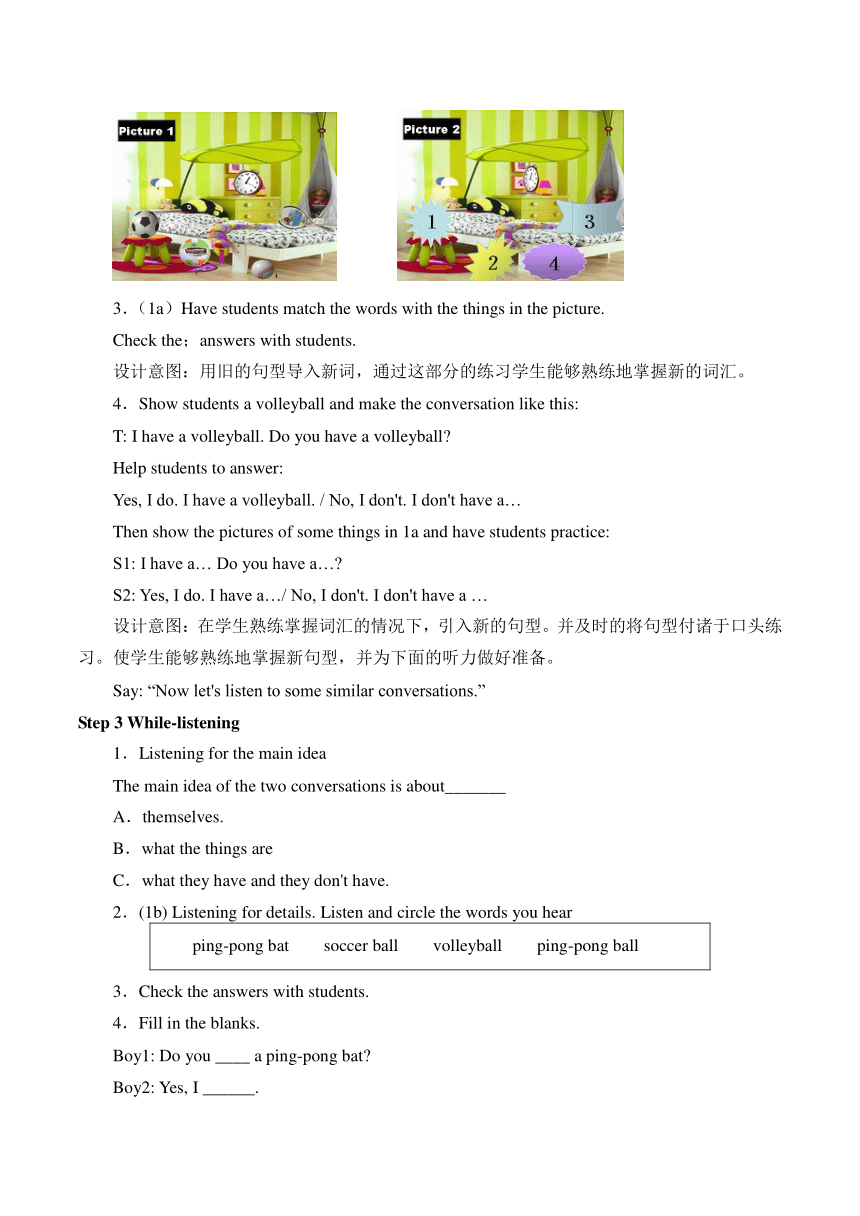鲁教版(五四制)六年级上册 Unit 8 Do you have a soccer ball? Period 1 教案
文档属性
| 名称 | 鲁教版(五四制)六年级上册 Unit 8 Do you have a soccer ball? Period 1 教案 |  | |
| 格式 | doc | ||
| 文件大小 | 278.0KB | ||
| 资源类型 | 教案 | ||
| 版本资源 | 鲁教版 | ||
| 科目 | 英语 | ||
| 更新时间 | 2022-11-24 17:44:23 | ||
图片预览



文档简介
Unit 8 Do you have a soccer ball
Period 1
Teaching Aims
知识目标:
1.能争取使用下列词汇(Curriculum words)
do, have , ball, tennis, volleyball, basketball, ping-pong , bat , soccer, soccer ball
2.能争取使用下列句型(Useful drills)
---Do you have a ping–pong ball
---Yes, I do. / No, I don't.
---Does he/ she have a ping-pong bat
---Yes, he/ she does. / No, he/ she doesn't
语言功能:能够听懂询问是否有某物的句子,并能用do和does引导的一般疑问句询问某人是否拥有某物。
学习策略:
1.预测阅读文章的大意。
2.将所学的单词按语义分类:体育运动词汇,描绘性词汇。
情感态度:
了解和体育运动有关的英语知识,并培养对运动的热爱。
Important and Difficult Points
能够听懂询问是否有某物的句子,并能用do和does引导的一般疑问句询问某人是否拥有某物。
Teaching Procedures
Step 1 Preview
一、写出球类名词的英文名称并翻译下列动词短语。
1.篮球__________
2.棒球___________
3.排球__________
4.足球__________
5.乒乓球________
6.网球__________
7.打乒乓球______________
8.打篮球________________
9.踢足球_________________
10.打棒球__________________
11.打网球__________________
12.打排球__________________
二、翻译句子。
1.你有乒乓球吗?是的,我有。
___________________________________.
2.你有乒乓球拍吗?不,没有。
___________________________________.
3.他有足球吗?是的,他有。
___________________________________.
4.她有排球吗?是的,她有/不,没有。
___________________________________.
Step 2 Warm up and lead in
1.Show a picture and make a conversation with students. And then show the students the conversation and the pictures below to students. And have students practice it:
T: What's this in English
S: It's a volleyball.
2.Play a game named “Who has the best memory ” Show picture 1 to students and have them watch it carefully and then show them picture 2 with some things covered. Then let them say the covered things out.
3.(1a)Have students match the words with the things in the picture.
Check the;answers with students.
设计意图:用旧的句型导入新词,通过这部分的练习学生能够熟练地掌握新的词汇。
4.Show students a volleyball and make the conversation like this:
T: I have a volleyball. Do you have a volleyball
Help students to answer:
Yes, I do. I have a volleyball. / No, I don't. I don't have a…
Then show the pictures of some things in 1a and have students practice:
S1: I have a… Do you have a…
S2: Yes, I do. I have a…/ No, I don't. I don't have a …
设计意图:在学生熟练掌握词汇的情况下,引入新的句型。并及时的将句型付诸于口头练习。使学生能够熟练地掌握新句型,并为下面的听力做好准备。
Say: “Now let's listen to some similar conversations.”
Step 3 While-listening
1.Listening for the main idea
The main idea of the two conversations is about_______
A.themselves.
B.what the things are
C.what they have and they don't have.
2.(1b) Listening for details. Listen and circle the words you hear
ping-pong bat soccer ball volleyball ping-pong ball
3.Check the answers with students.
4.Fill in the blanks.
Boy1: Do you ____ a ping-pong bat
Boy2: Yes, I ______.
Boy1: _____ you have a ping-pong _____
Boy2: ______, I don't.
设计意图:在学生掌握新句型的基础上,听听力,降低了听力的难度。能够加深学生对句型的印象。
Step 4 After-listening
Get the students read after the tape, pay attention to the pronunciation and intonation.
设计意图:培养学生的语感,掌握正确的发音和语调。
Step 5 Presentation and practice
1.Teacher has a student with a volleyball stand up and says: “He has a volleyball.” Then points to another student without a volleyball and asks: “Does he have a volleyball ” Help students to answer: Yes, he does. He has a volleyball. / No, he doesn't. He doesn't have a volleyball. Have students pay more attention to “has”.
2.(2c)Show the pictures below to students and have them practice the drills.
设计意图:第一人称练习熟练后,及时地引入第三人称的练习。学生能够对比,然后记忆和掌握。同时让学生在操练中掌握语言知识,形成语言技能。
Step 6 Listen(2a-2d)
1.Listen to the conversations and number the pictures.
2.Listen again .Match the pictures in 2a with the balls.
3.Listen to the tape again and fill in the blanks.
Jane ____________ a baseball.
Paul ___________ a soccer ball.
Dale ___________ a volleyball.
Mike ___________ a basketball.
设计意图:在熟悉句型以后,我们进行听力练习。降低了听力的难度,增加了学生的自信心。
Step 7 Role play the conversation in 2d
1.Ask and answer questions about the conversation.
(1)Does Cindy the baseball __________________
(2)Where is Helen's Jacket __________________
2.Put the conversation into Chinese.
3.Role-play the conversation in pairs .Then go to the front of the classroom and perform it to the whole class.
设计意图:充分利用听力材料训练学生听的能力和培养学生的语音语调。
Step 8 Inquiry into knowledge by translation
1.Does he have a ping-pong ball Yes, he does. /No, he doesn't.
____________________________ ________________________
I don't _________ (have) a soccer ball. (我没有足球)
He doesn't ___________ (have) a ping-pong ball.(他没有乒乓球)
(1)句中的____和_____是构成疑问句和否定句的助动词,位于疑问句句首.
(2)构成否定句时,do not缩写为___________does not缩写为:___________
don't/doesn't+动词原形构成否定句.
(3)do作实义动词,意为________
E g.: I do my homework every day.(我每天做作业)
改为疑问句:Do you do your homework every day (你每天都做你的作业吗 )
have v. 本单元中的意思为“有”,表达某人有某物:
前两个单元我们学了用物主代词表示所属关系,This is my father.(这是我的父亲)Is this your pen (这是你的钢笔吗?)本单元我们将学会用have表示所属关系,have“有”,强调拥有或占有,是所属关系。如:
I have a soccer ball. I have a ping-pong ball.
我有一个足球。 我有一个乒乓球。
(1)谓语动词have在句中有两种形式,即_____和_____。have用于第一人称的单数和复数(I、we),第二人称(you)和第三人称复数(they或其他复数名词等),has用于____________he, she,it或单数名词。
I / We have a computer. 我/我们有台电脑。
You / ________a computer. 你/你们有电脑。
They / Jim and Tom ________a computer. 他们/吉姆和汤姆有台电脑。
Kate / She _______ a computer.凯特/她有电脑。
(2)have用于肯定句时,如果主语是第三人称单数(he/ she/ it)时have要变为_______,变为一般疑问句时,要在句首加助动词_____或______(主语第三人称单数时为does),加助动词后have用原形。have的否定句,要在其前加助动词don't或doesn't, have要还原。
2.Let's play baseball.
译:_______________________。Let's为_______的缩写,意思是_______,play是动词,意思是______。在表示某种球类运动时,其结构为play +表示球类的名词。如:我不打球。I don't _______.
3.That sounds good. 译:______________.
Sound是系动词,意思是________,形容词good作表语,构成主系表结构。
设计意图:鼓励学生通过合作学习自己总结,训练学生观察、发现、语言现象,归纳和掌握语言规律的能力。
Homework
1.根据课本背诵录音原文。
2.完成助学SectionA-2c内容。
3.练习。
一、根据汉语提示完成句子。
1.你有一只棒球拍吗?
_____you ______ a baseball
2.埃里克有一个网球吗?
_____ Eric ______ a _______ ball
3.戴尔有一个足球和一个排球。
Dale _____ a ______ ball and a _________.
4.我有一个篮球和一只乒乓球拍。
I___ a basketball and ____.
二、用所给词的适当形式填空。
1.I ____ (have) a ping pong.
2.I ________ (have) a pen.
3.Does he _______ (have) a book
No, ______________.
4.Jim ______________ (not have) a pen.
5.____they _______ (have) soccer balls
Yes, _________.
三、翻译下列短语或句子。
1.every day_____________
2.watch TV________________
3.play basketball__________
4.play volleyball______________
5.play computer game_________
6.That sounds interesting._________________
四、根据句意及首字母提示完成单词。
1.Playing computer games is very i__________.
2.Math is d_________, I don't like it.
3.—Let's play guessing (猜测) games.
—That sounds f____.
4.—Let's go to the beach (海滩).
—That sounds r____.
5.—Let's play volleyball.
—No, it's b_________.
设计意图:解决问题形式上采用小组互评,以学评教,强化分层落实,学生帮学生,面向全体学生,用实践来检验所学知识。
PAGE
Period 1
Teaching Aims
知识目标:
1.能争取使用下列词汇(Curriculum words)
do, have , ball, tennis, volleyball, basketball, ping-pong , bat , soccer, soccer ball
2.能争取使用下列句型(Useful drills)
---Do you have a ping–pong ball
---Yes, I do. / No, I don't.
---Does he/ she have a ping-pong bat
---Yes, he/ she does. / No, he/ she doesn't
语言功能:能够听懂询问是否有某物的句子,并能用do和does引导的一般疑问句询问某人是否拥有某物。
学习策略:
1.预测阅读文章的大意。
2.将所学的单词按语义分类:体育运动词汇,描绘性词汇。
情感态度:
了解和体育运动有关的英语知识,并培养对运动的热爱。
Important and Difficult Points
能够听懂询问是否有某物的句子,并能用do和does引导的一般疑问句询问某人是否拥有某物。
Teaching Procedures
Step 1 Preview
一、写出球类名词的英文名称并翻译下列动词短语。
1.篮球__________
2.棒球___________
3.排球__________
4.足球__________
5.乒乓球________
6.网球__________
7.打乒乓球______________
8.打篮球________________
9.踢足球_________________
10.打棒球__________________
11.打网球__________________
12.打排球__________________
二、翻译句子。
1.你有乒乓球吗?是的,我有。
___________________________________.
2.你有乒乓球拍吗?不,没有。
___________________________________.
3.他有足球吗?是的,他有。
___________________________________.
4.她有排球吗?是的,她有/不,没有。
___________________________________.
Step 2 Warm up and lead in
1.Show a picture and make a conversation with students. And then show the students the conversation and the pictures below to students. And have students practice it:
T: What's this in English
S: It's a volleyball.
2.Play a game named “Who has the best memory ” Show picture 1 to students and have them watch it carefully and then show them picture 2 with some things covered. Then let them say the covered things out.
3.(1a)Have students match the words with the things in the picture.
Check the;answers with students.
设计意图:用旧的句型导入新词,通过这部分的练习学生能够熟练地掌握新的词汇。
4.Show students a volleyball and make the conversation like this:
T: I have a volleyball. Do you have a volleyball
Help students to answer:
Yes, I do. I have a volleyball. / No, I don't. I don't have a…
Then show the pictures of some things in 1a and have students practice:
S1: I have a… Do you have a…
S2: Yes, I do. I have a…/ No, I don't. I don't have a …
设计意图:在学生熟练掌握词汇的情况下,引入新的句型。并及时的将句型付诸于口头练习。使学生能够熟练地掌握新句型,并为下面的听力做好准备。
Say: “Now let's listen to some similar conversations.”
Step 3 While-listening
1.Listening for the main idea
The main idea of the two conversations is about_______
A.themselves.
B.what the things are
C.what they have and they don't have.
2.(1b) Listening for details. Listen and circle the words you hear
ping-pong bat soccer ball volleyball ping-pong ball
3.Check the answers with students.
4.Fill in the blanks.
Boy1: Do you ____ a ping-pong bat
Boy2: Yes, I ______.
Boy1: _____ you have a ping-pong _____
Boy2: ______, I don't.
设计意图:在学生掌握新句型的基础上,听听力,降低了听力的难度。能够加深学生对句型的印象。
Step 4 After-listening
Get the students read after the tape, pay attention to the pronunciation and intonation.
设计意图:培养学生的语感,掌握正确的发音和语调。
Step 5 Presentation and practice
1.Teacher has a student with a volleyball stand up and says: “He has a volleyball.” Then points to another student without a volleyball and asks: “Does he have a volleyball ” Help students to answer: Yes, he does. He has a volleyball. / No, he doesn't. He doesn't have a volleyball. Have students pay more attention to “has”.
2.(2c)Show the pictures below to students and have them practice the drills.
设计意图:第一人称练习熟练后,及时地引入第三人称的练习。学生能够对比,然后记忆和掌握。同时让学生在操练中掌握语言知识,形成语言技能。
Step 6 Listen(2a-2d)
1.Listen to the conversations and number the pictures.
2.Listen again .Match the pictures in 2a with the balls.
3.Listen to the tape again and fill in the blanks.
Jane ____________ a baseball.
Paul ___________ a soccer ball.
Dale ___________ a volleyball.
Mike ___________ a basketball.
设计意图:在熟悉句型以后,我们进行听力练习。降低了听力的难度,增加了学生的自信心。
Step 7 Role play the conversation in 2d
1.Ask and answer questions about the conversation.
(1)Does Cindy the baseball __________________
(2)Where is Helen's Jacket __________________
2.Put the conversation into Chinese.
3.Role-play the conversation in pairs .Then go to the front of the classroom and perform it to the whole class.
设计意图:充分利用听力材料训练学生听的能力和培养学生的语音语调。
Step 8 Inquiry into knowledge by translation
1.Does he have a ping-pong ball Yes, he does. /No, he doesn't.
____________________________ ________________________
I don't _________ (have) a soccer ball. (我没有足球)
He doesn't ___________ (have) a ping-pong ball.(他没有乒乓球)
(1)句中的____和_____是构成疑问句和否定句的助动词,位于疑问句句首.
(2)构成否定句时,do not缩写为___________does not缩写为:___________
don't/doesn't+动词原形构成否定句.
(3)do作实义动词,意为________
E g.: I do my homework every day.(我每天做作业)
改为疑问句:Do you do your homework every day (你每天都做你的作业吗 )
have v. 本单元中的意思为“有”,表达某人有某物:
前两个单元我们学了用物主代词表示所属关系,This is my father.(这是我的父亲)Is this your pen (这是你的钢笔吗?)本单元我们将学会用have表示所属关系,have“有”,强调拥有或占有,是所属关系。如:
I have a soccer ball. I have a ping-pong ball.
我有一个足球。 我有一个乒乓球。
(1)谓语动词have在句中有两种形式,即_____和_____。have用于第一人称的单数和复数(I、we),第二人称(you)和第三人称复数(they或其他复数名词等),has用于____________he, she,it或单数名词。
I / We have a computer. 我/我们有台电脑。
You / ________a computer. 你/你们有电脑。
They / Jim and Tom ________a computer. 他们/吉姆和汤姆有台电脑。
Kate / She _______ a computer.凯特/她有电脑。
(2)have用于肯定句时,如果主语是第三人称单数(he/ she/ it)时have要变为_______,变为一般疑问句时,要在句首加助动词_____或______(主语第三人称单数时为does),加助动词后have用原形。have的否定句,要在其前加助动词don't或doesn't, have要还原。
2.Let's play baseball.
译:_______________________。Let's为_______的缩写,意思是_______,play是动词,意思是______。在表示某种球类运动时,其结构为play +表示球类的名词。如:我不打球。I don't _______.
3.That sounds good. 译:______________.
Sound是系动词,意思是________,形容词good作表语,构成主系表结构。
设计意图:鼓励学生通过合作学习自己总结,训练学生观察、发现、语言现象,归纳和掌握语言规律的能力。
Homework
1.根据课本背诵录音原文。
2.完成助学SectionA-2c内容。
3.练习。
一、根据汉语提示完成句子。
1.你有一只棒球拍吗?
_____you ______ a baseball
2.埃里克有一个网球吗?
_____ Eric ______ a _______ ball
3.戴尔有一个足球和一个排球。
Dale _____ a ______ ball and a _________.
4.我有一个篮球和一只乒乓球拍。
I___ a basketball and ____.
二、用所给词的适当形式填空。
1.I ____ (have) a ping pong.
2.I ________ (have) a pen.
3.Does he _______ (have) a book
No, ______________.
4.Jim ______________ (not have) a pen.
5.____they _______ (have) soccer balls
Yes, _________.
三、翻译下列短语或句子。
1.every day_____________
2.watch TV________________
3.play basketball__________
4.play volleyball______________
5.play computer game_________
6.That sounds interesting._________________
四、根据句意及首字母提示完成单词。
1.Playing computer games is very i__________.
2.Math is d_________, I don't like it.
3.—Let's play guessing (猜测) games.
—That sounds f____.
4.—Let's go to the beach (海滩).
—That sounds r____.
5.—Let's play volleyball.
—No, it's b_________.
设计意图:解决问题形式上采用小组互评,以学评教,强化分层落实,学生帮学生,面向全体学生,用实践来检验所学知识。
PAGE
同课章节目录
- Unit 1 Good morning
- Section A
- Section B
- Unit 2 What's this in English?
- Section A
- Section B
- Unit 3 What color is it?
- Section A
- Section B
- Unit 4 My name's is Gina
- Section A
- Section B
- Unit 5 This is my siste
- Section A
- Section B
- Unit 6 Is this your pencil?
- Section A
- Section B
- Unit 7 Where's my schoolbag?
- Section A
- Section B
- Unit 8 Do you have a soccer ball?
- Sectioan A
- Sectioan B
- Unit 9 Do you like bananas?
- Section A
- Section B
- Unit 10 How much are these socks?
- Section A
- Section B
